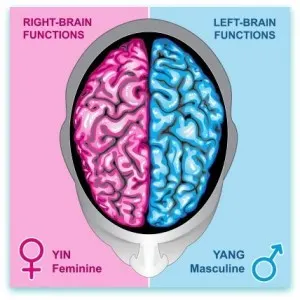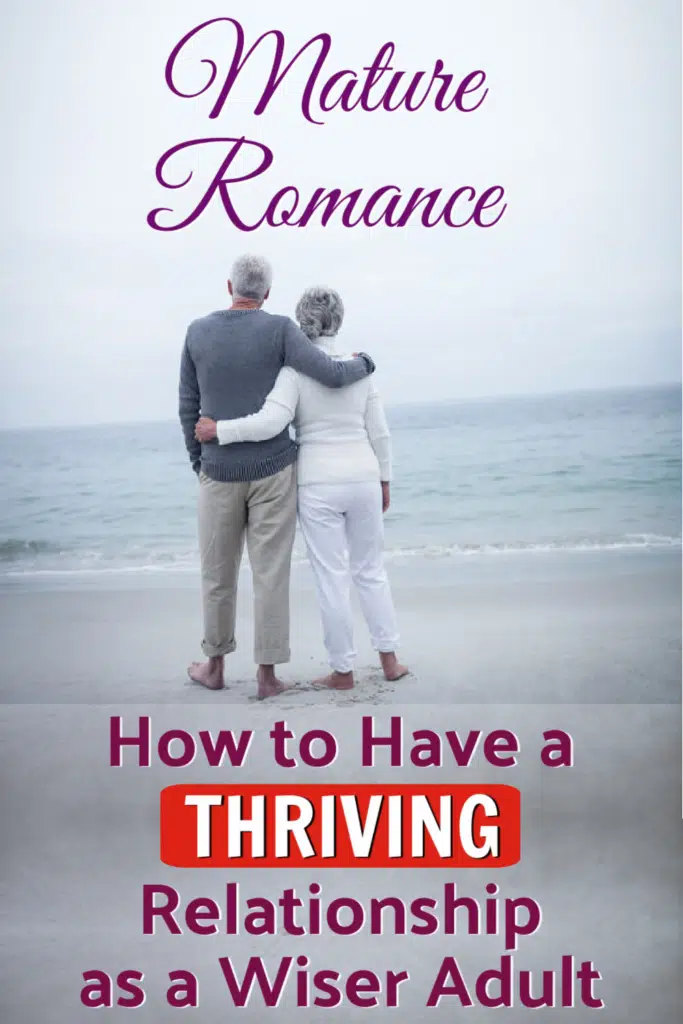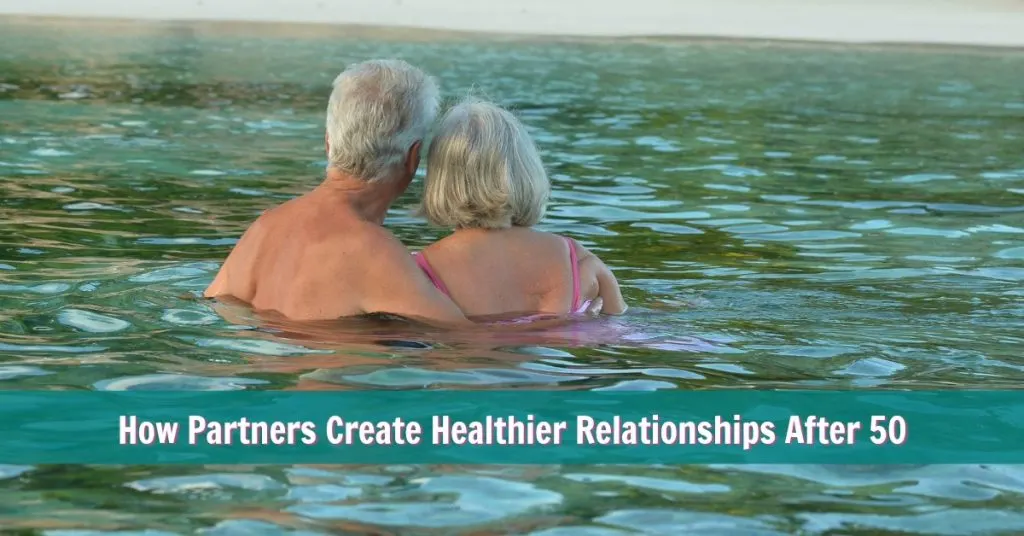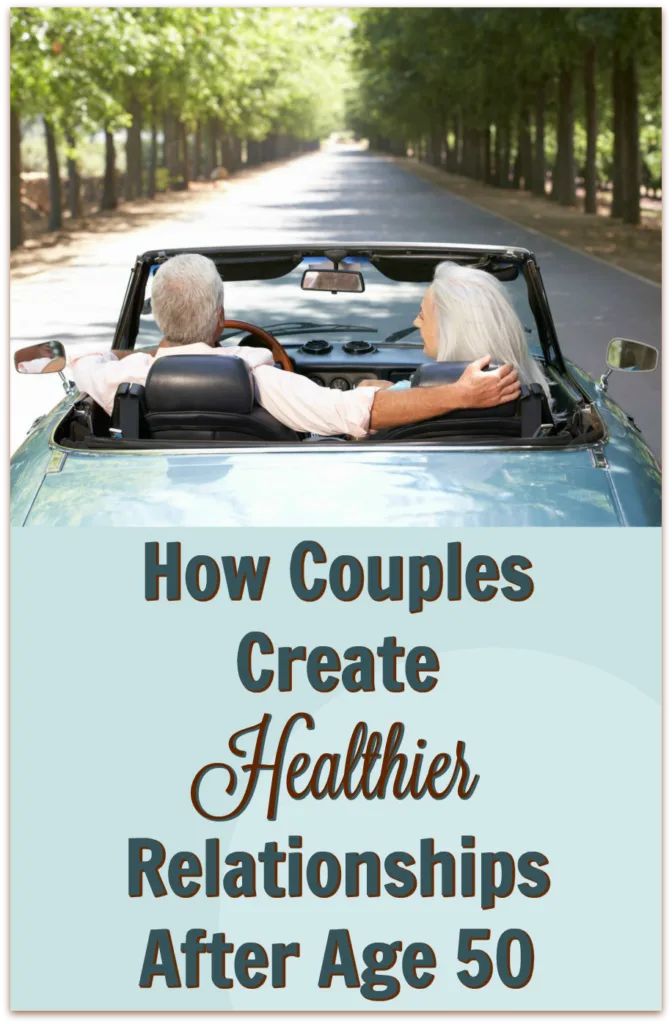You can create a partnership that stands the test of time. Romantic affirmations for marriage and love over 50 will improve compatibility and deepen intimacy.
- Are you looking for a partner to form a healthy and loving bond with?
- Or perhaps you have a lifemate now and seek to make the relationship more meaningful and satisfying?
Either way, the romantic affirmations for love and marriage located lower within this article will likely prove helpful – whether you are over 50 already or, hoping to have a thriving partnership that lasts into your fifties and beyond.
How Romantic Partners Exchange Love Energy
Romantic energy manifests in two styles of relating: yin and yang.
A romantic relationship will work best – in the long term – when one person emphasizes yin-energy and the other emphasizes yang-energy.
This is not about politics or anatomy, it’s about: energy. It works as well for same-gender couples as it does for heterosexual couples.
Reversed Energies Can Help Build a Healthy and Happy Relationship that Lasts a Lifetime
Long-term, romantic partners work less well if you get two yins together or two yangs together.
- When two yins get together, the sex will often fizzle out eventually.
- When two yangs get together, there are often power struggles.

Find Your Soulmate (or Rekindle the Flame): The Yin & Yang Approach to Love
If we’re observant of nature, this should come as no surprise. A tree breathes in carbon dioxide and breathes out oxygen. Humans do the opposite.
Even blood is a balance of alkaline and acid. It’s no wonder they say opposites attract.
Suppose you’re hoping to find new love over 50. In that case, the following principles will work just as well for you as for someone who is already in a committed relationship: figuring out what romantic energy you’re best at expressing and then emphasizing that particular energy when you’re with your partner or potential partner.
The Old Saying Is True: Opposites Do Attract
Yin and yang in relationships work like exchanging carbon dioxide and oxygen. The yang partner offers yang in exchange for yin, and the yin partner receives yang energy and gives back yin energy.
Of course, each of us is both yin and yang (feeling/thinking, responsive/initiating).
However, almost every person slightly emphasizes one of these energies more than the other.
“Are you yin or yang? Emphasizing one of these inner energies could make all the difference in your romantic relationship.”
When someone with slightly more yang teams up with someone with slightly more yin, there tends to be romantic compatibility. These are the couples who are still making love 30 years later.
Couples with opposite energies even tend to enjoy better health and do better financially.
Unleash Your Romantic Soul: Tips for Thriving Love After 50
Simply put, a union of souls creates a synergy often lacking in other love relationship models.

This exchange loop is how people come to feel deeply understood by one another, and we call this a Union of Souls.
This is the “matrimonium” of opposites that Carl Jung explored in such great depth in Mysterium Coniunctionis: heat/cold, masculine/feminine, conscious/unconscious.
“It’s difficult to balance on a fence, and it’s uncomfortable to sit on one.”
The One Question to Ask Your Partner to Help Your Relationship Get Back on Track
Yin and yang have become a bit cliché in modern society, but sometimes clichés exist for a reason.
For example, let’s take a quick look at the brain.
Though brain hemispheres do not have precisely defined roles, for simplification, we can generally (but accurately) attribute thought to the left lobe and feeling to the right.
We can also say:
- left lobe = mostly initiating
- right lobe = mostly responsive
Are you seeing how applicable this is to the energy of relationship dynamics?
Is Your Relationship in Sync? Find Out with the Yin & Yang Test
Here’s a hint: almost always, a person finds it more comfortable and natural to say one of these to their partner:
▸ “What can I do to help you?“ (what a respectful Yin asks a Yang when things are a bit tense)
▸ “How can I help you feel better?“ (what a cherishing Yang asks a Yin when things are a bit tense)
I can almost guarantee you that you’re slightly better at asking one of these questions than the other.
At first glance, you might believe that both of these questions come equally easy to you, but be advised by Dr. Pat Allen’s words: “it’s practically impossible to salute and hug someone in the exact same moment.”
In a Union of Souls relationship model (based on the aforementioned exchange loop of reciprocity), you choose between leading most of the time or following most of the time.
The paradox is this: if you consciously decide which of the two you will emphasize, you will end up getting both.
The two lobes are connected via the corpus callosum. But, in relationships, people often treat the corpus as though it were a lobe unto itself. What I mean by that is simply this:
It’s difficult to balance on a fence, and it’s uncomfortable to sit on one.
People straddle the fence intending to have everything at once in their romance. By expecting it all instantly, they end up with nothing.
Conversely, by choosing to stand firmly on one side of the fence or the other, they can have it all. The corpus callosum is like a bridge. You don’t want to set up shop there, but it’s a good thoroughfare for paying a visit to the other side.
- In your relationship, are you naturally inclined to emphasize your left lobe or your right?
- Do you feel that you and your partner have an exchange loop of yin and yang energy that fosters a Union of Souls?
Love Over 50: Romantic Affirmations for All Types of Couples
Mornings, or at night right before bed, are excellent times to do affirmations for love and marriage. Affirmations are positive messages that you confirm out loud to yourself. Alternatively, you can also use these affirmations as journal prompts:
- “I am learning to delight in the differences between others and me. I am understanding that I would not want to be married to somebody who is exactly like me, so I’m finding the humor in being with somebody who has different strengths and weaknesses than I do.”
- “I have faith in myself to say “no” to things that are immoral or unethical; therefore, I don’t have to struggle or worry to change little things about my partner just to make my own life more convenient.”
- “I am responsible for my own happiness and fulfillment. I can find the things I enjoy in life and participate in them. My partner does not have to have the same opinions, methods, or interests that I do. I am empowered to understand that I can realize my potential without blaming my partner.”
- “All couples have to negotiate issues around labor, parenting (scheduling, screen time, sugar, etc.), and finances. These are specific agreements that can be hammered out as particular challenges arise. It’s a natural part of the process, and we can always see a counselor for help with this.”
- “Yesterday, I wrote down one thing about my partner [or imagined future partner] for which I feel grateful. Today, there is a completely new thing about my partner for which I feel grateful, and that is…”
What Drives Our Desire to Mate for Life?
Why do many of us make the transition from romance to marriage?
The real reasons for this primary relationship may surprise you.
Sustaining our happiness in life – and increasing happiness over time – hinges on our ability to be extremely honest with ourselves. One area in particular where humans find it difficult to be honest with themselves is: the relationship.
Understanding our true relationship motivators is challenging because, though we like to think that we have complete clarity about why-we-want-what-we-want, the fact is our beliefs about romance are an ideology born from our:
- biology (especially our hormones)
- childhood experiences
- family of origin
- culture
- current circumstances
…and – let’s face it – the thousands of hours of television and movies we’ve watched over the years.
This ideology we’ve created in our brains may or may not be compatible with how relationships actually work successfully.
At the beginning of a courtship, especially, we desire romance.
Ah, romance.
Romance has a delicious, hard-to-define quality that goes beyond just attraction. There’s spontaneity there. A mystery that we want to hold as a mystery, without ever solving it.

Why We Turn Romance into Modern Marriage
We delight in romance – even crave it – because we have an intrinsic need to have our feelings cherished and our thoughts respected by a person with whom we are sexually bonded.
Romance blends passion with friendship.
A deep interest in one another’s thoughts and feelings is what makes it more than merely a sexual adventure.
Like all reductive approaches to understanding, we come to find is that the whole is greater than the sum of its parts, and dissecting motivations only takes us so far.
In his book, The Evolution of Desire, David Buss examines research results from a Harvard study involving 10,000 participants.
Each was interviewed extensively to determine their true motivations for taking that step from romance to marriage – and their answers were not what one might expect.
While you might assume answers like:
◕ “tradition”
◕ “it’s what people do” (social convention)
◕ “to symbolize our love”
◕ “to demonstrate our commitment”
However, the most common answers were far more pragmatic; mainly, people confided that their primary reason for marriage was one of these two:
◕ dependable sensuality
◕ financial security
Sex and money: the two big energy systems on the planet that – though they’re not exactly politically correct topics when speaking of marriage – can be deeply spiritual systems through which we experience and demonstrate our compassion and understanding in earthly ways.

Any psychic wounds from our imperfect childhoods tend to appear in sex or money as adults. They are the areas in which we act out. They are our growth opportunities.
Buss’ research has been validated by the work of Dr. Pat Allen, who has counseled many thousands of married couples over her long career and who has also written books about her findings.
Emergence: That Certain Something-Else in a Romantic Relationship
Many couples move to take to their relationships to another level – beyond convenience, beyond romance, beyond co-parenting.
They want something else.
“In love” is often little more than code for romantic chemistry based on biological bonding deeply rooted in sex.
Likewise, “security” is often code for financial freedom.
No, this something else runs even more profound. It’s a sort of spiritual teamwork, but it reaches even further than values.
Perhaps, ultimately, it’s about being a piece of the whole that is greater than the sum of its parts.
It could be that marriage is most spiritual when what emerges from it leaves the world a better place – as a result of its dynamic love.
Are You Magnetic? (How to GRAB a Lover’s Attention)
Many men tune out of the conversation after listening to the first 12 words.
Should women take this personally?
Active listening is one of the most essential social skills that exist.
Men with excellent listening skills are generally well-regarded by their peers and abundant in meaningful relationships.
However, it’s a good idea to be respectful of all men regardless of their listening style.
Many men have brain styles wired for action – for doing rather than being – and it’s essential to understand this as more of a biological event instead of something to be taken personally.

Why Men Stop Listening
Approximately one-third of men have a brain-style that is relational – meaning they can track long conversations while effortlessly holding direct eye contact.
However, when interacting with the majority of men, your wisest strategy is to try to load the most critical information in your opening sentence.
People Who Think Out Loud
If Mary calls her friend Kate from the car to tell her that she’s going to be 20-minutes late to their appointment, she begins the conversation by telling the funny story of the zany and unexpected things that have happened to her so far that morning.
Kate has no problem tracking Mary’s tale and laughs along with her friend at the highlights of the story.
In the same scenario – except Mary is phoning George instead of Kate — Mary phones George and opens with, “I’m running about 20 minutes behind.”
When speaking with a man, Mary knows to hit the main bullet point of the conversation right at the beginning (instead of first telling the story of what happened to make her late).
It’s not always easy to train oneself to speak in this bullet point style, but it is possible to learn with time and practice.
Are You a Non-Linear Thinker?
Learning a bullet point conversational speaking style is especially challenging for non-linear thinkers (… like me!).
When I’m relaxed and comfortable with someone, I like to share my process, and sort of think my way – out loud – to a new idea or conclusion.
My brain tends toward holistic, and I often circle around a thought as I find my way to it.
However, I’ve learned when speaking with other, more linear-minded men that this does not work so well.
Many men are always listening for the “kernel,” the essential point that you are (or aren’t) making.
For this reason, thinking out loud is a communication style that often backfires.
It feels good to get everything off your chest, but the person with whom you’re sharing this stream of consciousness – particularly if he happens to be male – tunes out of the conversation early on by half-listening. Then, on some unconscious level, you will be taken a little less seriously the next time you speak.
How to Be Truly Heard
Researchers have been able to identify brain-style differences:
- men and women process information differently and use conversation for different reasons
- approximately two-thirds of women use conversation as a means of affection – to be relational
- approximately two-thirds of men use conversation as a means of imparting tangible information
- right-handed men process differently than left-handed men
- straight men process differently than gay men
All of this diversity makes life rich and interesting, but it can also make it frustrating if we communicate with everyone as though they process precisely as we do – they probably don’t.
If you enjoy the sensation of being fully heard by another human being –of having people be genuinely interested in what you’re saying –then a useful rule of thumb in conversation is to make your point in 12 words or less.
Men’s brains are wired in such a way that when they listen, they’re listening for the “nugget” – the part of what you’re saying that is most relevant to them.
Therefore, the trick to being heard is to take the most important part of what you’re about to say and load it at the front of your conversation.
It’s the classic principle they taught us in journalism class: the lead sentence of your opening paragraph has to have punch – what happened? to whom? where? when? why?
Is there a problem you want solved? Something you need? A feeling to share? Whatever is most important: lead with it.
“…most people have never really been listened to. Because listening can bring about such powerful healing, it is one of the most beautiful gifts that people can give and receive. When parents listen to children, valuing the children’s feelings as much as their own, they convey to the children the sense that their processes of responding to life are respected. The children can trust themselves to deal with experience and conflict. It is this faith that helps children to move in the world, knowing that they are alright, and feeling that they can deal with whatever comes. There is no greater gift that parents can give than to help their children develop this faith” ~ Carl. A Faber, On Listening
For many women (or yin-energy men, like myself), casual conversation is a form of affection and fondness.
For many men, domestic banalities and idle small talk have the opposite effect – they suck the romantic energy out of the room.
Because everyone is different, we need to be aware of each other and compromise when we can.
It takes a bit of self-discipline and lots of practice.
This has valuable implications for everyone in business. Still, it also has the potential to help partners feel heard in their romances and friends to better understand each other in their friendships.
The Art of Concise Conversation
Research suggests that right-handed men use less than half as many words as women do.

90% of men are right-handed. So, if you’re a woman in a relationship with a right-handed man, this is something to be aware of.
It’s not that these reticent men don’t have a broad vocabulary – it’s that they find fewer words get the job done (this same advice applies to a left-handed man conversing with a right-handed man).
Instead of a monologue about why you can be ready by 7 o’clock, why not simply state: “I can be ready by 7”?
This way, he knows what he needs to know, and his mind hasn’t wandered by the time you’ve arrived at your bottom line (he can sense when you’re about to launch into a diatribe…and he usually stops listening after the first 12 words anyway).
One could argue that it’s the right-handed men who should adjust, not everyone else.
However, I think it’s often simpler to consciously change speaking habits than listening habits, and a shift to concise speaking makes for more efficient communication regardless.
Because I’m a person who likes to figure things out as I speak, I sometimes find my way to a new, larger point as I’m speaking – a different point than I intended to make before I opened my mouth.
Many people are like me in this way, but I also recognize that many people are not.
How I negotiate this (when I’m speaking to someone who has a communication style that’s different than mine) is to try to put what I expect will be the most important part of what I’m going to say in my opening line.
It’s a more respectful way to speak with people; you might be surprised to find how well that works for you, too.
Why One Marriage Has More Love than Another Marriage
Though it’s not so difficult to keep a relationship exciting in the early years together, the real trick for any marriage (including same-gender ones) is to create a thriving, healthy, joyful, and passionate relationship decades into the marriage.
To do this, each spouse needs to understand “The Loop” – how romantic partners exchange energy within a union of souls.
To keep passion robustly alive within a marriage, partners do well to honor the mysteriousness of attraction by choosing words carefully:
- the partner who isn’t communicative enough needs to stretch and share their internal process more often;
- the partner who chatters too much needs to become grounded enough to create more relaxed, empty spaces.
Desire and attraction are sensitive, mercurial dynamics that are largely generated by the looping of yin/yang energy.
Or, to put it in more Western terms, the mutual exchange of respectfulness and cherishing.
The best marriages recognize that sex and money are energy systems in which profound self-improvement opportunities exist.
Lasting Love Secrets: Yin & Yang for Couples Over 50
Our primary relationships tend to receive our energy leftovers.
Your decision of who to choose for a lifemate is arguably the most critical decision you make in your lifetime. So it’s ironic that, over time, we tend to switch to auto-pilot in our daily interactions with this most important person.
Everyday living has a way of sometimes dulling a marriage.
The chaotic pace of modern life can especially take a toll – it’s pretty easy to become worn down by all the happenings within an average day, an average week, and an average year.
On the other hand, a healthy romantic relationship can help stabilize and restore us in challenging times – and that is why helping your romantic relationship to shine again is wise.

The tangible results of a marriage that is firing on all cylinders will be reflected in the couple’s health (it will usually be robust), their finances (solvent), their lovemaking (regular), and their spiritual impact (their coupling tends to leave the world a better place than it would have without their coupling).
However, none of us is perfect.
We’re all works-in-progress, and so are our marriages.
Sometimes one of these relationship cylinders will shut down, and that is an appropriate time to run a marriage diagnostic.
3 Styles of Romantic Love Relationships
Why is it that some marriages are the casualty of a hectic day while others are the antidote?
The answer is found in the differences within the fundamental dynamic of the relationship.
If two partners have a similar intention for the style of connection they seek, then their relating tends to go well, and their partnership is consistently reinvigorated.
An essential first step towards cultivating what you want in your marriage or partnership after the age of 50 is to become aware of your patterns: do they work for or against your desires for true romantic intimacy
Typically, three types of dynamics are at play within a romantic relationship, and often these dynamics play out on an unconscious level.
These three styles of relating apply to all couples (including same-gender couples) of any age.
One style is not better than the other.
How could it be?
We’re all on different paths at different times, learning different lessons.
The point here is to increase your awareness about your past styles and current style so that you can move closer to the style of relationship you most desire.
Which of the three styles is best for you?
Romance #1 – The Drama Triangle Romantic Relationship
In a drama-triangle relationship, one person has to be the loser, and the other has to be the winner.
The roles can shift from time to time, but there is rarely a sustained win-win environment for each person.
When we commit ourselves to be in this sort of relationship, there is an underlying agreement that real love means that: someone is constantly losing.
Where do we develop such an unconscious belief?
Usually, it’s rooted in our early childhood experiences and the relationships we saw modeled by our relatives or family of origin.
It’s called a triangle because there are three possible roles at any given moment: persecutor, rescuer, or victim.
It tends to be a very passionate, high-drama relationship.
The style may not be so good for your long-term physical health. However, in its own way, it can be very intimate.
Romance #2 – The Less-Risk Romantic Relationship
Though the couple in this dynamic may live together and share a bed, they tend to maintain almost everything else as though they were still single.
This can include their financial, social, and professional lives.
People who are drawn to these types of relationships want to minimize the risk and loss that are inherent possibilities in all relationships.
However, in the hopes of negating the prospect of pain, they sometimes lose out on the rewards of deeper intimacy.
The upside to this style of relationship is that one is perhaps able to maintain greater independence.
Romance #3 – The Union of Souls as Love Partners
In this relationship style, the couple can negotiate a mutual interdependency for the greater good.
This dynamic requires facing fears, changing habits, and finding new ways to communicate and compromise.
Downside: Though all three styles of relationships require work, this one also requires the most change. (We’re talking about lasting change, which can be very difficult.)
Upside: In exchange for honest and open work, partners will often benefit from a sense of freedom and strength within a tender and encouraging union.
A frequently searched phrase on Google is “who has the best marriage?”
Many people across the globe type this question into Google’s search field every month because they’re wondering if anybody out there is doing it perfectly.
The answer is: no.
Relationships are work. And as the saying goes, “love is a verb.” That means that each day requires some effort and consciousness in order to help the primary relationship thrive.
- Which style hasn’t worked well for you in the past?
- Which of these three styles of relationships best describes your own experiences so far?
- If you have been able to shift away from destructive patterns and into healthier habits, what were the keys to your success?
Beyond Cupid: Unleash Your Inner Romantic (or Rekindle It) with Yin & Yang
Valentine’s Day reminds us that we can periodically tend to the romantic energy system at play within our own lives.
Many people focus on what Cupid is going to bring them.
This is backward.
Valentine’s Day is an opportunity to further develop the qualities that you bring (or could bring) to a romantic relationship.
What is your stellar romantic quality? Are you still celebrating romance?
Perhaps you are:
- good at cherishing others’ feelings?
- good at helping others to feel seen, heard, and tended to?
- good at helping others to feel respected?
- compassionate?
- brilliant?
- scintillating?
- a good provider?
- a good lover?
Or maybe you have that rare gift for being a potentially exceptional parent to your and your spouse’s future offspring. Whatever the unique gift is, each of us can bring something to the relationship table.
The Parable of Cupid’s Love Potluck
There’s a Valentine’s Day potluck at Cupid’s house – and you’re invited! But will you show up empty-handed?
This short parable can help you to get into the real spirit of Valentine’s Day, whether you happen to be in a relationship right now or single.
Cupid phones you up and invites you to a Valentine’s Day potluck at his place. You tell him you’re all set and not interested in a fix-up, but he assures you it’s not a matchmaking party – it’s a potluck to celebrate romance!
You’re not sure what to bring to a celebration of romance. Dessert, perhaps? But Cupid makes it clear: “I want you to bring the one best quality you have to offer in a romantic relationship.”
It’s the evening of Cupid’s potluck.
As you approach the house, you see other guests heading up to the front door. Many of them look interesting and fun, and you get that pre-party ripple of excitement in your stomach.
You continue your approach, carrying a large pot containing your best quality. You clench your potluck contribution to your chest, uncertain of what others will bring, and your stomach feels a little jumpy.
When you arrive at the door, Cupid greets you warmly and points to a large table at the end of the room. “Welcome! So glad you could make it! Bring your quality in and set it there on the table,” he instructs cheerfully.
As you enter, you notice a few of the other guests have arrived empty-handed.
Setting your large bowl on the table, you notice an eager expression from those nearby as you prepare to remove the lid.
Everyone smiles and makes delighted “Oh!” sounds.
You are relieved. You realize your romantic quality will be a hit at Cupid’s table. Your stomach unknots and you are ready to enjoy a relaxed and fun-filled evening.
Thank goodness you didn’t show up empty-handed – especially when you have so much to offer.
Whether you’re hoping to find a new romance or simply to improve the romantic relationship you already have, the concept of what you bring to the love table will help you to cultivate that properly.
Come alone or bring a date – just don’t come to the party empty-handed and expect to have a good time.
- In what ways are you still celebrating romance in your life?
- How can you further unleash the romantic inside of you?

Additional Sources about Healthy Romantic Partners Building Love
“Alchemy of Love and Lust” ~ Theresa Crenshaw https://www.kirkusreviews.com/book-reviews/theresa-l-crenshaw-2/the-alchemy-of-love-and-lust/
“Teaching and Brain Research” ~ Michael Grady http://teacherlink.ed.usu.edu/yetcres/catalogs/reavis/301.pdf
“It’s a Man’s World and a Woman’s Universe” ~ Patricia Allen, PhD
“The Right Mind: Making Sense of the Hemispheres” ~ Robert Ornstein http://www.publishersweekly.com/978-0-15-100324-2
“Sex Difference in the Corpus Callosum / Journal of Neuroscience” ~ MF Richey http://www.jneurosci.org/content/11/4/933.short

Man Up with a Green Smoothie • Over Fifty and Fit
Wednesday 13th of March 2019
[…] bodies use the oxygen in the air we breathe to help create the energy we need in our daily lives. The O2 we breathe in is […]
Mat Exercise Program for Strength and Flexibility – A No-Gym Workout
Thursday 28th of February 2019
[…] – most importantly – as your chest comes up off the mat during the rock-back, be sure to “mate” your pelvis into the mat to protect your lower […]
Stronger Abs! 12 Exercises to Help You Develop Firm Core Muscles • Over Fifty and Fit
Saturday 6th of October 2018
[…] protect your back, you want to “mate” your pelvis into the […]
8 Strategies to Increase Your Daily Stamina - Over Fifty and Fit
Saturday 5th of May 2018
[…] a starting point – to acquaint you with the process of meditation and to give you a chance to explore how you respond to some different […]
15 Uncommonly Effective Ways to Get Your Life Back Together
Saturday 14th of April 2018
[…] is one aspect of the natural law of attraction at play in the […]